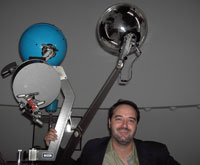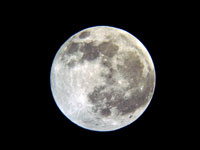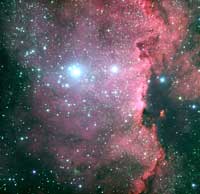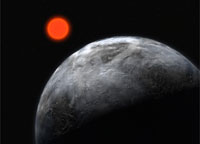A star-struck teacher in Italy Inspire article
Research offers exciting and challenging job opportunities, but sometimes the price to pay in terms of personal sacrifice is very high. Claudia Mignone interviews a young astronomer who found satisfaction in the classroom – teaching mathematics.

Image courtesy of Alessandro Berton
Astronomy has always been Alessandro Berton’s greatest passion: after his undergraduate studies at the University of Padua, Italy, he moved to the Max Planck Institute for Astronomy in Heidelberg, Germany, for his PhD. His research focused on the development of new, cutting-edge techniques to detect extrasolar planets. The quest for planets outside our solar system has been one of the most fascinating topics in astronomy for the past 15 years (see Jørgensen, 2006 and Fridlund, 2009), and Alessandro was thrilled to be a part of it. Yet something was missing.
“During those years, I always felt the lack of social, human interaction – a lack that is typical of many research environments,” he explains. “I longed for a job where I could spend more time with other people than in front of my computer screen.” Hence, a few months after receiving his PhD, Alessandro enrolled in the Italian high-school teacher-training program, and at the same time he began to teach mathematics to his very first students.
“I had been thinking about teaching long before the end of my PhD,” he admits. As an undergraduate student of astronomy, Alessandro had occasionally worked for a small observatory, taking care of the planetarium and telescopes, and introducing schoolchildren to the mysteries of the night sky. He enjoyed this job a lot, but more than that, he was really good at it. Nearly every other day during his PhD, Alessandro wondered whether it would be better to go on with his research, or to leave it and start teaching.

The scientific work involved in a PhD has its natural ups and downs. Sometimes you have to wait longer than you wished, and the results are not as exciting as you had hoped. Yet you have to hide your scepticism and always look bright and confident: let’s not forget it is a highly competitive environment. This competitiveness was not one of Alessandro’s favourite aspects of astronomy: the environment of a school, with your own students, where you are the only person in charge within the four walls of your classroom, sounded much more appealing to him.
With several, contradictory thoughts on his mind, Alessandro decided to give teaching a try. After all, he already knew how he felt about research. He discovered that he had made the right decision. “It was exactly what I was looking for,” he says, smiling. “Every day something different happens. There is the pleasure of preparing a lesson, the joy of teaching, the thrill of explaining things… On top of it, you have to deal with a bunch of 14- to 19-year-old students: an extremely delicate task, but most of the time it’s a lot of fun!”
After two years of teaching, Alessandro’s impression is entirely positive: “The feedback from your own students is an overwhelming reward. Nothing compares to such a feeling.” Nearly every day, after teaching, he goes home with some small satisfaction, whereas during his previous research work, daily gratification was just about impossible to achieve.
He acknowledges, however, that the transition was not exactly smooth. When I ask him what he misses most from his research years, the answer erupts immediately: “Astronomy!”

extrasolar planet Gliese 581 c
Image courtesy of ESO
Unfortunately, the Italian school system only allows astronomy graduates to teach mathematics or physics, basic subjects of an astronomer’s education; strangely enough, astronomy is counted amongst the natural sciences, along with chemistry, biology and geology, and is taught by graduates of other subjects. “It’s a struggle to see my students learning astronomy from a teacher who does not share my enthusiasm for the subject,” he says. It is almost inevitable that you will miss something that has been such a big part of your life for years. Alessandro tries to compensate for this through amateur astronomy and science communication. His dream, however, is to teach his own after-school class – covering not only basic astronomy but also real astronomical observations and data analysis.
In the meantime, Alessandro uses astronomy as a motivational tool. Motivating students every day is probably the most difficult task for a teacher. When difficult mathematical concepts are introduced, a practical example can be very helpful. And where would he draw his examples from, but from astronomy? “When I had to explain logarithmic equations, I drew a parallel to the magnitude system used to classify stars. When we were dealing with conic sections, I told them the orbit of the Earth around the Sun is an ellipse, and that of a comet is a parabola.” The students were excited, mostly because they could spot (and appreciate) a high degree of motivation in the teacher himself.

extrasolar planet Gliese 581 c
Image courtesy of ESO
Although years spent doing research may not be the standard training for a teacher, they have interesting advantages: the lack of practical experience in the classroom is compensated by experience of day-to-day scientific research, which makes the delivery of a scientific message more straightforward. Alessandro became aware of this fact during an unusual teaching activity he’s recently been involved in: a robotics lab class. The students were asked to build a little robot with sensors, which they then used for small experiments. Although the experiments were of minor importance, such as studying the motion of the robot along an inclined plane, the class taught them something of a much greater value: the scientific method.
“My active research background was very useful: unlike other teachers at my school, I had concrete experience of doing science,” he shyly admits. “It was a pleasure to watch the students learn how to take measurements properly and treat statistical error, how to draw conclusions and summarise them in a report that slightly resembled a scientific paper.”
After two years, Alessandro is still very satisfied with his choice, and is looking forward to the beginning of the new school year. “It is a difficult job though, and you cannot start teaching if you are not truly convinced,” he points out. “After all, you have the students’ future in your hands”. He suggests to young scientists who might consider the option of moving to the classroom: “If you think you have enough patience, communication and organisation skills, and you are looking for a job for which human contact is crucial, then think about teaching.
“When you’ve finished thinking, think again. Maybe try some teaching activities, or science communication – if you enjoy it, then you might be a good teacher. And then, good luck!”
References
- Fridlund M (2009) The CoRoT satellite: the search for Earth-like planets. Science in School 13: 15-18.
- Jørgensen UG (2006) Are there Earth-like planets around other stars? Science in School 2: 11-16.
Web References
- w1 – To learn more about the European Southern Observatory (ESO), see: www.eso.org
Review
There is always a drift between working in science and technology and teaching, for a variety of reasons. Here is a good example – a dedicated astronomer who became a dedicated teacher. Teachers could use this article in a range of contexts, including demonstrating the appeal of science and illustrating the different careers available to scientists.
Eric Deeson, UK





